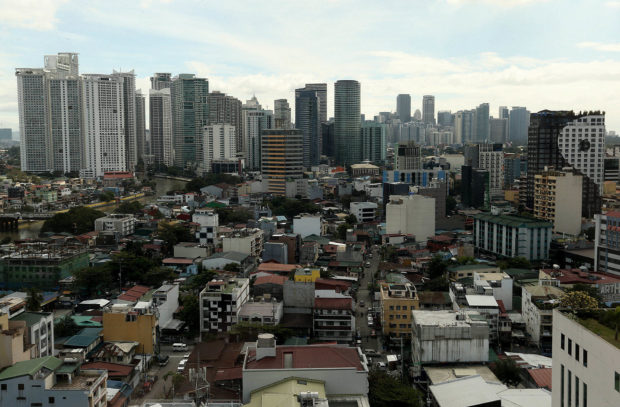2 multilateral institutions see lower 2022 PH GDP growth

(file photo) The skyline of Makati Business District in Makati City. The Philippine economy fell to its worst post-World War II recession in 2020 amid the COVID-19 pandemic, aggravated by the onslaught of natural disasters from the eruption of Taal Volcano to a string of devastating typhoons.
INQUIRER PHOTO / RICHARD A. REYES
MANILA, Philippines—Two multilateral institutions expect the Philippines’ gross domestic product (GDP) to grow below the government’s 7 to 9 percent target this year, as lingering high inflation risks wrought by Vladimir Putin’s rape of Ukraine and surging COVID cases in China present a threat to domestic consumption and external trade.
The regional surveillance organization Asean+3 Macroeconomic Research Office (Amro) kept its 6.5-percent 2022 GDP growth forecast for the Philippines, citing improving manufacturing activity and domestic demand amid further economic reopening while COVID-19 infections continued to drop.
Amro’s estimates showed that retail sales growth in Asean+3 (which includes China and Hong Kong, Japan and South Korea) was the highest in the Philippines — a 21.4-percent jump in February compared to January.
At a press briefing on Tuesday (April 12), Amro chief economist Hoe Ee Khor said this year’s growth “will be led by government spending and also recovering private-sector spending.”
“The Philippine economy has a pretty large output gap. So we expect that private spending will bounce back very rapidly once the economy is open much more fully,” Khor said.
“We are quite confident that this 6.5-percent percent growth can be achieved this year. And we expect growth of another 6.5 percent for next year,” Khor added. The government targets 6 to 7 percent GDP expansion in 2023.
However, Amro projected headline inflation in the Philippines to breach the 2 to 4 percent target range of manageable price hikes and average 4.1 percent this year amid faster increases in food and fuel prices.
Across the region, Amro flagged the spillover impact of Putin’s war on Ukraine on consumer prices, although it deemed current inflation levels as still manageable. “The war in Ukraine is an emerging risk if prolonged — the conflict can amplify existing risks, derailing the region’s recovery prospects,” Khor said.
Asked if Amro expects the Bangko Sentral ng Pilipinas (BSP) to raise key interest rates — the policy rate now stands at a record-low 2 percent — to ease high inflation, Khor replied: “The Philippine economy still has a negative output gap — it has not fully recovered to pre-pandemic levels. So demand is still — I wouldn’t say it’s very weak, but it’s still modest.”
“On the demand side, we don’t see very strong impetus to growth. So because of that, I think, if inflation is likely to decline down to within the target band by next year, then we don’t see the need to raise policy rates, per se,” said Khor. Amro estimated inflation to average 3.5 percent in 2023.
“It’s important to make sure that inflation doesn’t become entrenched. And there’s scope for the BSP to start considering withdrawing some of the policy stimulus, as the economy continues to gain traction and growth continues to recover,” Khor said.
In a report also on Tuesday, UK-based think tank Oxford Economics said it expects food inflation in Asia-Pacific to peak during the third quarter of this year, “but not at alarming levels.”
“Other than China, whose record grain stocks position it well to absorb global price shocks, net food importers will feel the global price pressures more. This includes all of advanced Asia, and the Philippines,” Oxford Economics head of India and Southeast Asia economics Priyanka Kishore said.
“We do not see a threat to Asia’s food security from Ukraine’s ban on grain exports or sanctions on Russia. However, the impact of significantly costlier grains, oilseeds, and farm inputs is likely to reverberate through the food basket and will more than offset any downside pressure from rice — the dominant grain in Asian CPI [consumer price index] baskets,” Kishore said.
“Other parts of the CPI basket will also feel spillover effects, particularly food services. Inflation in prepared meals, restaurants, and other food service categories has spiked as higher food prices have compounded upside pressures from ‘catch-up’ demand, rebounding tourism and soaring energy prices” across Asia-Pacific, Kishore added.
Also on Tuesday, the United Nations Economic and Social Commission for Asia and the Pacific’s (Unescap) Economic and Social Survey of Asia and the Pacific 2022 report showed a 2022 GDP growth forecast of 6.3 percent for the Philippines, and a faster 6.7-percent expansion for 2023. Unescap nonetheless estimated within-target inflation of 3.5 percent this year, which would further ease to 2.5 percent next year.
For Unescap, “moderation in China’s consumption, exports and industrial activities will no doubt weigh on the region’s growth momentum, given the interlinkages of its economy with several other economies in the region.” China was currently grappling with its worst COVID-19 infection rates since the pandemic started in 2020.
“A slowdown in China is likely to spill over to the rest of Asia through lower trade, particularly for capital goods, machinery and electrical goods with key partners, such as Indonesia, Malaysia, the Philippines, Singapore, Thailand and Vietnam,” Unescap said.
“China’s ‘zero COVID-19’ strategy is also a risk not only to its domestic demand, investment and tourist arrivals but also to countries highly reliant upon tourist arrivals from China, such as Cambodia, the Philippines and Thailand,” Unescap added.
